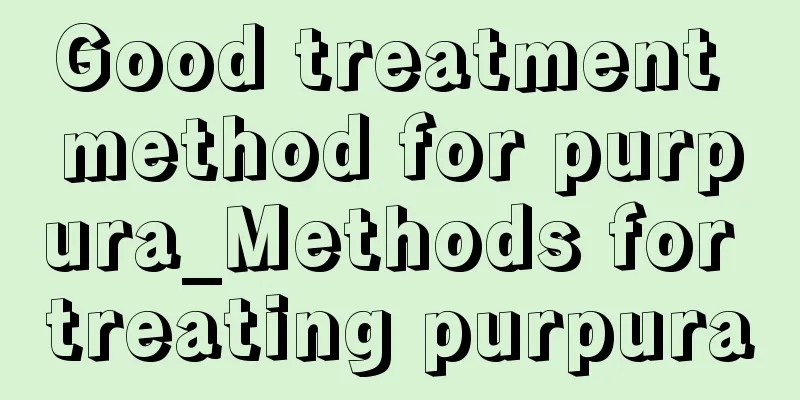Good treatment method for purpura_Methods for treating purpura

|
Purpura is a disease that requires timely treatment because if it is not controlled in time, it is likely to worsen. Of course, there are many methods that can be used to treat purpura. No matter which treatment method is chosen, the cause must be eliminated first. So, what are the effective treatments for purpura? The following will give you a detailed introduction! 1. Methods for treating purpura First of all, we need to eliminate the cause of the disease. Such as controlling infections, eliminating parasites, and avoiding contact with allergenic items, including allergenic medicines and foods. 2. Antihistamines You can take diphenhydramine, chlorpheniramine, phenergan, clematis, and Mindy orally, or use 10% calcium gluconate 10ml plus 50% glucose injection, slowly inject intravenously, etc. 3. Corticosteroids It can resist allergies and improve capillary permeability, and has significant effects on abdominal pain, gastrointestinal bleeding, joint pain and edema of this disease, but it cannot prevent kidney disease and recurrence. Commonly used prednisone is 1mg-2mg per kilogram of body weight per day, taken all at once or in divided doses. In severe cases, hydrocortisone or dexamethasone can be given by intravenous drip. 4. Immunosuppressants The therapeutic effect is better for patients with severe symptoms, long course of illness, and poor efficacy of corticosteroids, especially those with nephrotic syndrome. The efficacy may be improved if used in combination with corticosteroids. Commonly used cyclophosphamide is 2mg-3mg per kilogram of body weight per day, intravenous drip, once a day or every other day, and then taken orally after it takes effect; or azathioprine is 2mg-3mg per kilogram of body weight per day, intravenous drip, and then taken orally in 2-3 times. After it takes effect, the dosage can be reduced to 0.5mg-1mg per kilogram of body weight for maintenance. Both should be used continuously for several weeks, and the dose can be adjusted according to changes in blood counts. 5. Other drugs Hemostatics, Anluoxue, vitamin C, rutin, etc. can reduce capillary permeability and alleviate bleeding tendency, and can be used as options. 6. Blockade therapy Procaine can be used at a dose of 3 mg to 5 mg per kilogram of body weight per day. After a negative skin test, add it to 500 ml of 5% glucose solution and drip intravenously once a day. One course of treatment is 7 to 10 days. 7. Traditional Chinese Medicine: Blood Stasis Blocking Collaterals The main symptoms are dark red or dark purple spots, recurring attacks, long course of disease, joint pain, skin and nail discoloration, dark lips, nails and eye sockets, dark purple tongue, and thin and wiry or stringy pulse. Treatment method: promote blood circulation, remove blood stasis, dispel wind and detoxify. The prescription is Taohong Siwu Decoction combined with Shixiao Powder. Commonly used medicines include peach kernel, safflower, Chuanxiong, red peony root, Millettia reticulata, moutan bark, Salvia miltiorrhiza, pollen charcoal, Platycladus orientalis leaf, agrimony, motherwort, Panax notoginseng, and flower stone. |
<<: Is thrombocytopenia anemia?
>>: Why can't people with purpura exercise
Recommend
Dietary considerations after colon cancer surgery
Colon cancer is fundamentally a malignant tumor. ...
What to do if the bridge of nose is crooked
The bridge of the nose is an important part of th...
Is esophageal cancer metastasis to the liver contagious?
Although esophageal cancer is a common and extrem...
What is liposome
We all know that animal fat has a particularly go...
What are the dangers of high blood sugar before meals and low blood sugar after meals?
Experts say that the causes of high blood sugar b...
Will you go blind if you have pterygium in your eyes?
If you find pterygium growing in your eyes, you m...
Sequelae of lobar pneumonia
Lobar pneumonia often occurs in young and middle-...
Raw boneless pork elbow
Many people love to eat pork elbows, and they all...
What to do if you have loose stools in the middle and late stages of ovarian cancer? What are the symptoms of middle and late stages of ovarian cancer?
The number of ovarian cancer patients in the worl...
How to diagnose lung cancer? Three major methods for diagnosing lung cancer as early as possible
The incidence and mortality of lung cancer have a...
Locust pose yoga detailed steps
Locust pose yoga is named after the posture that ...
What are the causes of recurrence of esophageal cancer surgery?
Patients with advanced esophageal cancer will exp...
What are the symptoms of mild mercury poisoning
Mercury is a relatively common chemical. It is ve...
Can osteosarcoma be cured? How to cure osteosarcoma
Osteosarcoma, like other malignant tumors, cannot...
What is the cause of tinnitus caused by kidney deficiency
Tinnitus due to kidney deficiency is also a type ...









